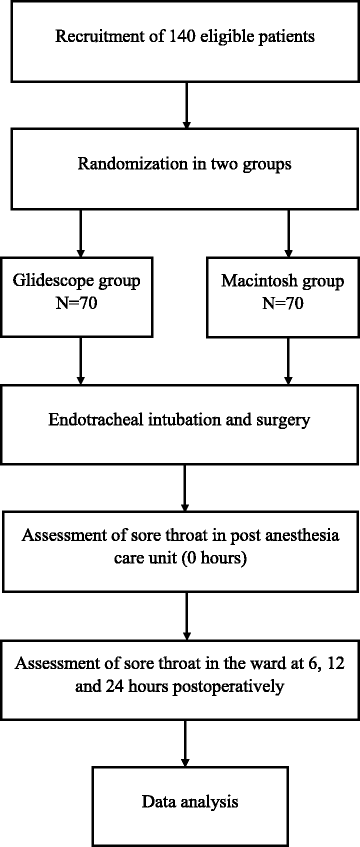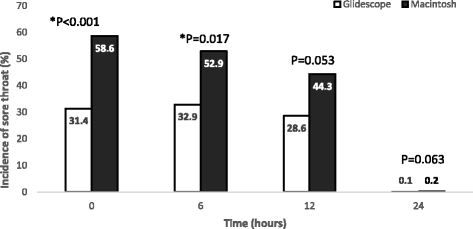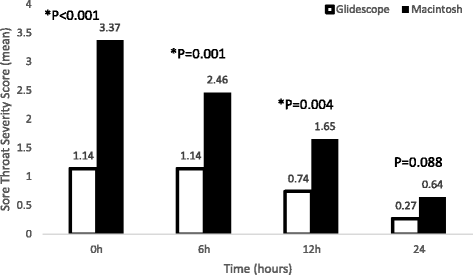Incidence and severity of postoperative sore throat: a randomized comparison of Glidescope with Macintosh laryngoscope
- PMID: 28899338
- PMCID: PMC5596501
- DOI: 10.1186/s12871-017-0421-4
Incidence and severity of postoperative sore throat: a randomized comparison of Glidescope with Macintosh laryngoscope
Erratum in
-
Correction to: Incidence and severity of postoperative sore throat: a randomized comparison of Glidescope with Macintosh laryngoscope.BMC Anesthesiol. 2018 Aug 17;18(1):112. doi: 10.1186/s12871-018-0575-8. BMC Anesthesiol. 2018. PMID: 30119647 Free PMC article.
Abstract
Background: Postoperative sore throat (POST) is a common problem following endotracheal (ET) intubation during general anesthesia. The objective was to compare the incidence and severity of POST during routine intubation with Glidescope (GL) and Macintosh laryngoscope (MCL).
Methods: One hundred forty adult patients ASA I and II with normal airway, scheduled to undergo elective surgery under GA requiring ET intubation were enrolled in this prospective randomized study and were randomly divided in two groups, GL and MCL. Incidence and severity of POST was evaluated at 0, 6, 12 and 24 h after surgery.
Results: At 0 h, the incidence of POST was more in MCL than GL (n = 41 v.s n = 22, P = 0.001), and also at 6 h after surgery (n = 37 v.s n = 23, P = 0.017). Severity of POST was more at 0, 6 and 12 h after surgery in MCL (P < 0.001, P = 0.001, P = 0.004 respectively).
Conclusions: Routine use of GL for ET tube placement results in reduction in the incidence and severity of POST compared to MCL.
Trial regisration: ClinicalTrials.gov NCT02848365 . Retrospectively Registered (Date of registration: July, 2016).
Keywords: Endotracheal intubation; Laryngoscope; Peroperative complications; Sore throat.
Conflict of interest statement
Ethics approval and consent to participate
This study was approved by the Institutional Review Board of King Khalid University hospital, Riyadh, Saudi Arabia. (Project No. E-11-298). As approved by the committee, a written, informed consent was obtained from all participants in this study.
Consent for publication
Not applicable.
Competing interests
The authors declare that they have no competing interests.
Publisher’s Note
Springer Nature remains neutral with regard to jurisdictional claims in published maps and institutional affiliations.
Figures
References
-
- Macario A, et al. Which clinical anesthesia outcomes are important to avoid? The perspective of patients. Anesth Analg. 1999;89(3):652–658. - PubMed
Publication types
MeSH terms
Associated data
LinkOut - more resources
Full Text Sources
Other Literature Sources
Medical




